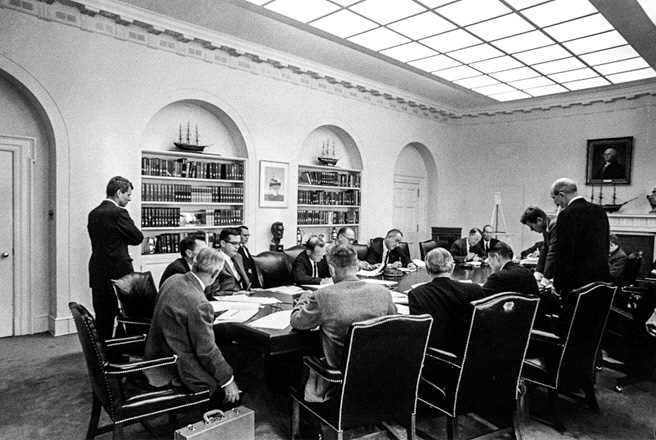M K Bhadrakumar |
History lends itself to re-interpretation when more facts become available or when ulterior motives creep in. There is a surfeit of the latter happening in India currently. Nothing is spared, even symbolically, in India’s history today – starting from Nehru’s legacy to Taj Mahal to Vinayak Damodar Savarkar. However, such revisionist history (‘historical negationism’) is interchangeable with fiction or folklore and on the whole, it fails to stick. Historical reappraisals are an entirely different thing.
Based on new archival materials becoming available every now and then, a slice of Cold War era history that is still dissected and understood from new perspectives is the so-called Cuban Missile Crisis of 1962. The narrative that was dominant initially was that the Soviets surreptitiously tried to deploy intercontinental ballistic missiles (ICBM) to Cuba targeting the US and the attempt was nipped in the bud with the Kennedy administration staring down the then Kremlin boss Nikita Khrushchev through a display of naval blockade of the island.
Incredibly enough, Pentagon had drawn up a detailed report on the overthrow of Fidel’s government by a military government headed by a US commander and military governor – something like the American occupation of Japan led by General Douglas MacArthur in September 1945.
As time passed, the informed sections of opinion came to know that it was a settlement negotiated through nerve-wracking back-channel negotiations directly between the Oval Office and the Kremlin – even Fidel Castro was kept in the dark – that brought the crisis to an end, with the Soviets and the Americans rolling back their missile respective deployments to each other’s backyard – Cuba and Turkey. The Soviets, true to character, eschewed triumphalism so long as the strategic objective was realized — namely the removal of the missiles in Turkey — leaving the Americans free to claim ‘victory’.
Read more: US-Russia relations under President Trump
However, what still remains less understood is that the crisis in 1962 was not just about the Soviet missile deployment. There was also alongside a full-bodied American agenda of ‘regime change’ in Cuba. Incredibly enough, Pentagon had drawn up a detailed report on the overthrow of Fidel’s government by a military government headed by a US commander and military governor – something like the American occupation of Japan led by General Douglas MacArthur in September 1945. Proclamation No 1 that was to have been issued, vested “all powers of government, executive, legislative, and judicial and all jurisdiction in the occupied territory and over its inhabitants” in the hands of the US military governor. The Proclamation stated:
All persons in the occupied territory (Cuba) will obey immediately and without question all enactments and orders of the military government. The resistance of the United States Armed Forces will be forcefully stamped out. Serious offenders will be dealt with severely. So long as you remain peaceable and comply with my orders, you will be subjected to no greater interference that may be required by military exigencies.
Also, leaflets were to be airdropped in their thousands all over Cuba advising that “U.S. armed forces will take temporary charge of your country.” They were to warn Cuban citizens to “remain at home” because “everything that moves is a target.”
Read more: ‘IS-Khurasan Province’ might drag Russia into the Afghan quagmire
Meanwhile, the Soviets too were factoring in a possible American invasion of Cuba, the fledgling socialist state in the Western Hemisphere, and therefore had secretly deployed tactical battlefield nuclear weapons to Cuba. With all the formidable intelligence gathering capacity at the disposal of the United States, the Americans had no inkling that if they invaded Cuba, they would have had a nasty surprise. In sum, the crisis had every potential to escalate into an apocalyptic event. (I am reminded of the recent bullish claim by our air chief that he knows precisely where and how to destroy Pakistan’s nuclear assets in one sweeping Indian air strike.)
To my mind, the most fascinating document is the (redacted) post-mortem report on the entire episode of the Cuban Missile Crisis authored by the famous CIA spook Richard “Dick” Lehman who worked with 7 American presidents from John F. Kennedy to George H.W. Bush and was credited with creating the president’s daily intelligence briefing and regarded as one of 50 trailblazers who created the CIA.
The above are facts culled out from documents that have been declassified in the US this week under the Freedom of Information Act (here). To my mind, the most fascinating document is the (redacted) post-mortem report on the entire episode of the Cuban Missile Crisis authored by the famous CIA spook Richard “Dick” Lehman who worked with 7 American presidents from John F. Kennedy to George H.W. Bush and was credited with creating the president’s daily intelligence briefing and regarded as one of 50 trailblazers who created the CIA. (For connoisseurs of Cold War history, Lehman’s recount of his 33 years in the world of intelligence archived in the CIA’s Library, here, makes fascinating reading.)
Read more: Why Russia suspects that US is helping ISIS in Syria &…
Much of what Lehman wrote will not come as stunning disclosure, but it is useful to know how carefully, meticulously, factually (backed with empirical evidence) an adversary’s strategic challenge needs to be studied and assimilated before the intelligence is taken to the desk of the political boss and it morphs into the stuff of decision-making. (I wonder how we fared in the run-up to the recent Doklam standoff with China.) Read Lehman’s Top Secret report to the CIA Director, here.
M. K. Bhadrakumar has served as a career diplomat in the Indian Foreign Service for over 29 years, with postings as India’s ambassador to Uzbekistan (1995-1998) and to Turkey (1998-2001). He writes extensively in Indian newspapers, Asia Times and the “Indian Punchline”. This piece was first published in Indian Punchline. The views expressed in this article are the author’s own and do not necessarily reflect Global Village Space’s editorial policy.














